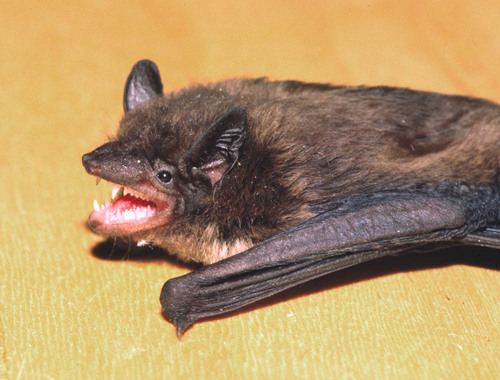
Evening bat
The Evening Bat (Nycticeius humeralis) is a small, insectivorous bat species common in the eastern and central United States. It plays a vital role in controlling insect populations, particularly agricultural pests. While not as well-known as some other bat species, the Evening Bat is an important component of North American ecosystems. It has no particular cultural significance, but its ecological role is crucial.
7-9 cm
Length
26-28 cm
Wingspan
Least Concern
Conservation Status
Distribution
Found primarily in the eastern and central United States, ranging from the Atlantic coast westward to Texas and Nebraska, and from southern Michigan and Pennsylvania southward to northeastern Mexico. They are not known for long-distance migrations, though some seasonal movements occur.
Lifespan
Typically 2-5 years in the wild, although some individuals may live longer.
Evening bat's Habitat
Habitat Types
Deciduous forests, Woodlands, Riparian areas, Agricultural lands
Climate Zones
Temperate, Subtropical
Adaptations
Evening Bats roost in tree hollows, beneath loose bark, and occasionally in buildings. Their relatively small size and maneuverability allow them to forage in cluttered environments.
Variations
Three subspecies are recognized: *Nycticeius humeralis humeralis*, *Nycticeius humeralis mexicanus*, and *Nycticeius humeralis subtropicalis*. These differ slightly in size and coloration.
Appearance
Breeding Plumage
No significant seasonal variation in fur color.
Seasonal Feather Changes
None
Sex Based Plumage Differences
Minimal
Notable Features
Dark brown fur on the back, Slightly paler fur on the belly, Short, rounded ears, Broad, black wings
Diet and Feeding
Primary Foods
Beetles, Moths, Flies, Other flying insects
Foraging Behavior
Evening Bats are aerial insectivores, catching prey in flight. They often forage along forest edges, over fields, and near water bodies. They typically emerge to feed shortly after sunset.
Specializations
Echolocation allows them to navigate and locate prey in low-light conditions.
Seasonal Diet Variations
Diet composition varies depending on the seasonal availability of insect prey.
Behavior
Social Structure
Evening Bats are colonial, particularly during the breeding season when females form large maternity colonies. Outside of the breeding season, they may roost in smaller groups or solitarily.
Communication
Echolocation calls for navigation and prey detection, Social calls for communication within the colony
Migration
Not considered a long-distance migratory species, but some populations may move locally or regionally in response to changing weather conditions or food availability.
Territorial or Group Behaviors
Maternity colonies are often defended by females, although the extent of territoriality is not fully understood.
Conservation
Threats
Habitat loss (deforestation), Pesticide use (reducing insect prey), Disturbance of roosting sites
Protection Programs
General wildlife conservation efforts, Habitat preservation initiatives
Local National Laws
Protected under various state and federal wildlife laws in the United States.
Population Trend
Stable
Population Estimates
Not Evaluated
Interesting Facts
They are one of the earliest bats to emerge in the evening.
This early emergence gives them access to insects that are active at dusk.
Females can store sperm over the winter.
This allows them to delay fertilization until spring, when food is more abundant.
They can fly up to 20 miles per hour.
This speed helps them catch fast-flying insects.
Faqs about Evening bat
Are Evening Bats dangerous to humans?
No, Evening Bats are not aggressive and rarely interact with humans. They are beneficial because they eat insects.
Do Evening Bats carry rabies?
Like all mammals, Evening Bats can carry rabies, but the incidence is low. Avoid handling any bat, especially one that appears sick or is acting abnormally. Consult a professional for medical or expert advice.
What should I do if I find a bat in my house?
If a bat is trapped in your house, try to isolate it in one room, open a window or door to the outside, and turn off the lights. The bat will usually find its way out. If it doesn't leave, contact animal control or a wildlife rehabilitator for assistance. Consult a professional for expert advice.
Copyright @ Nature Style Limited. All Rights Reserved.
 English
English